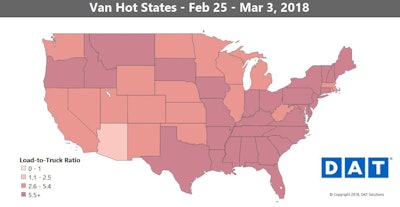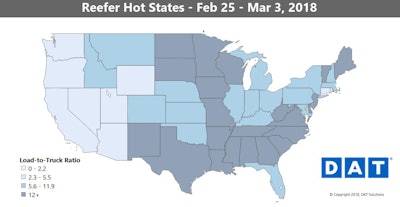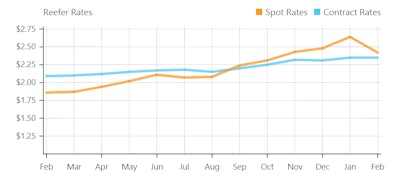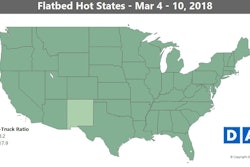 Volumes were up for the second week in a row as rates seemed to begin to turn for dry vans after weeks of slow decline. We could have a strong, early start to the spring freight season.
Volumes were up for the second week in a row as rates seemed to begin to turn for dry vans after weeks of slow decline. We could have a strong, early start to the spring freight season.Van rates reversed course last week after a month and a half of steady declines. It still remains to be seen if the uptick was due to end-of-month urgency on the part of shippers, but it could be a sign that van rates are turning the corner into a busy spring season.
Hot markets: Truckload demand out of California has lagged in the past month or so when compared to the rest of the country, but volumes got a big boost last week out of Los Angeles and Stockton, Calif. Load counts were up the most in Chicago. From a pricing standpoint, the big story was that rates rose on 66 of the top 100 van lanes.
Not so hot: Rates on the lane from Columbus, Ohio, to Buffalo, N.Y., soared last week, but the biggest declines were on other inbound lanes to Buffalo. For example, Chicago-to-Buffalo rates were down 30 cents to an average of $3.03 per mile, while the northbound lane from Charlotte to Buffalo lost 17 cents at $2.69 per mile.
 While reefer trends largely mirrored van through February, the rate fall-off was sharper.
While reefer trends largely mirrored van through February, the rate fall-off was sharper.Reefer overview: The national average spot market rate for reefers edged down to $2.40 per mile last week, but that’s still higher than the average reefer contract rate. In fact, the average spot rate has been higher than the average contract rate for six consecutive weeks – something that usually only happens in June. Volumes also jumped up 9 percent last week, and Easter should boost reefer demand in the coming weeks.
 Spot market reefer rates have exceeded contract counterparts since September of last year, which could bode well for the rest of the year’s worth of direct-shipper negotiations for carriers as pricing adjusts to the new market reality. Find an interactive version of this chart and similar for flatbed and van via DAT’s Trendlines site.
Spot market reefer rates have exceeded contract counterparts since September of last year, which could bode well for the rest of the year’s worth of direct-shipper negotiations for carriers as pricing adjusts to the new market reality. Find an interactive version of this chart and similar for flatbed and van via DAT’s Trendlines site.Easter also happens to land on April 1 this year, the same day that trucks will start being placed out of service if they fail to comply with the ELD mandate. All of that has the potential to create some especially tight reefer markets this month and beyond.

Hot markets: Rates out of Florida could go higher as we move closer to April, but a couple lanes got a head start. Reefer loads going from Miami to Atlanta paid 24 cents better at $1.75 per mile, while the average rate on the lane from Lakeland, Fla., to Charlotte shot up 50 cents to $2.57.
Not so hot: Lots of eggs ship out of Grand Rapids, Mich., and those tend to move cheap. As a result, it’s not uncommon ahead of Easter to see load counts out of that market rise even as the average rate falls, which is exactly what happened last week.










